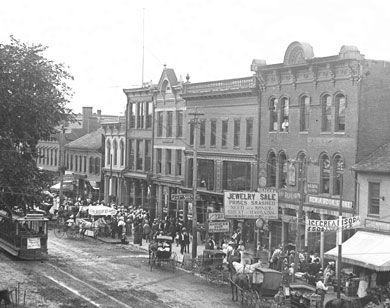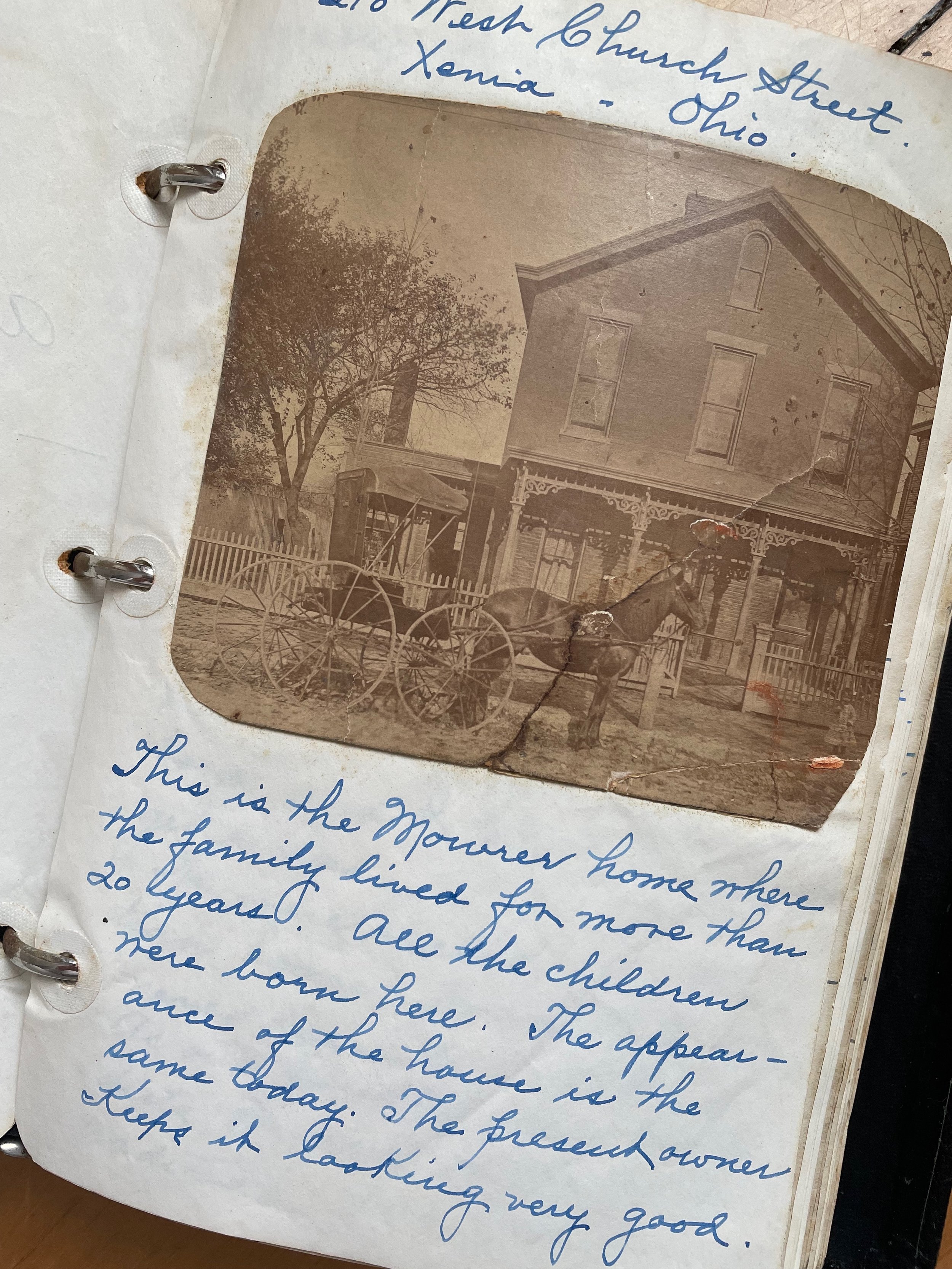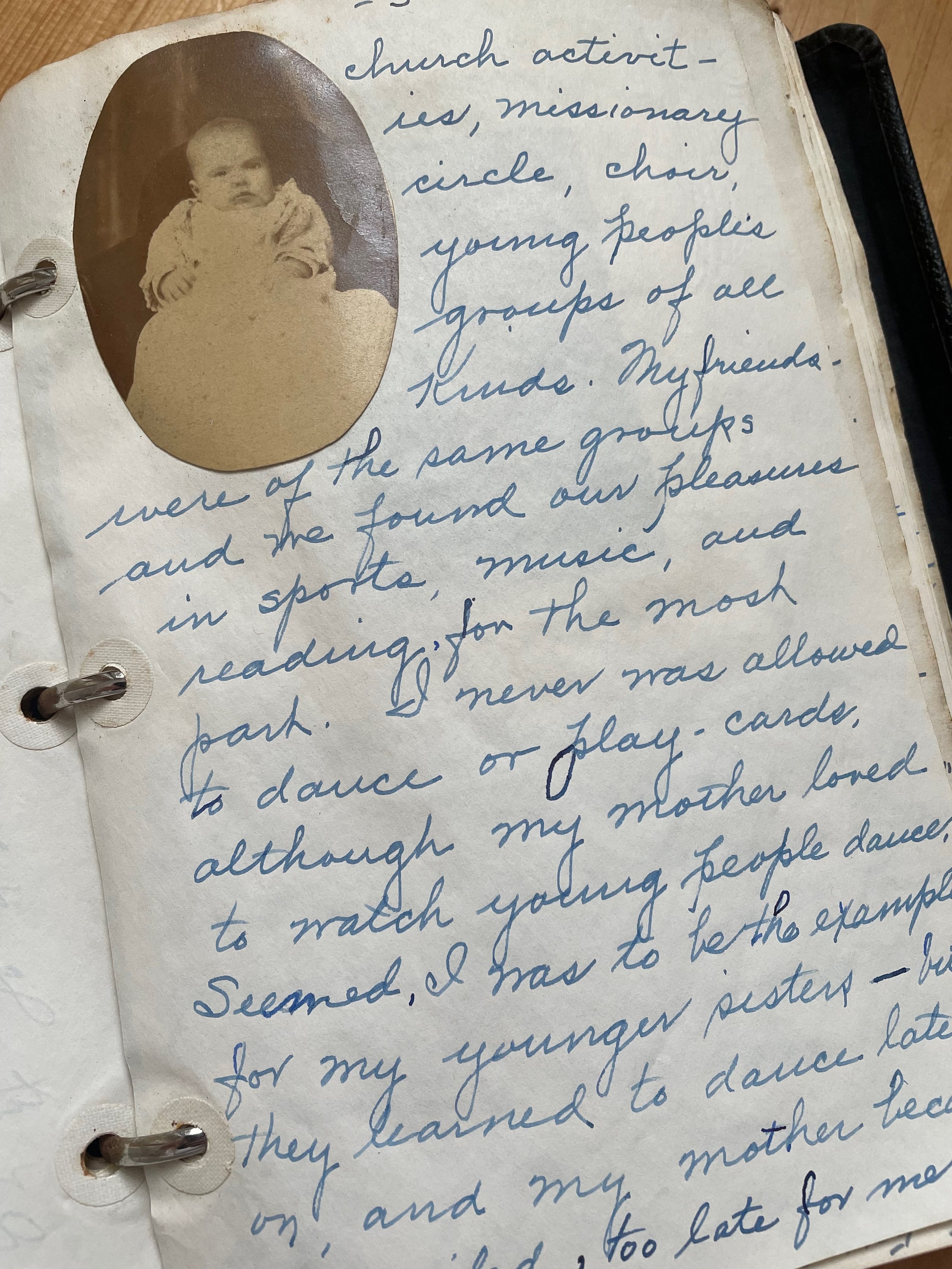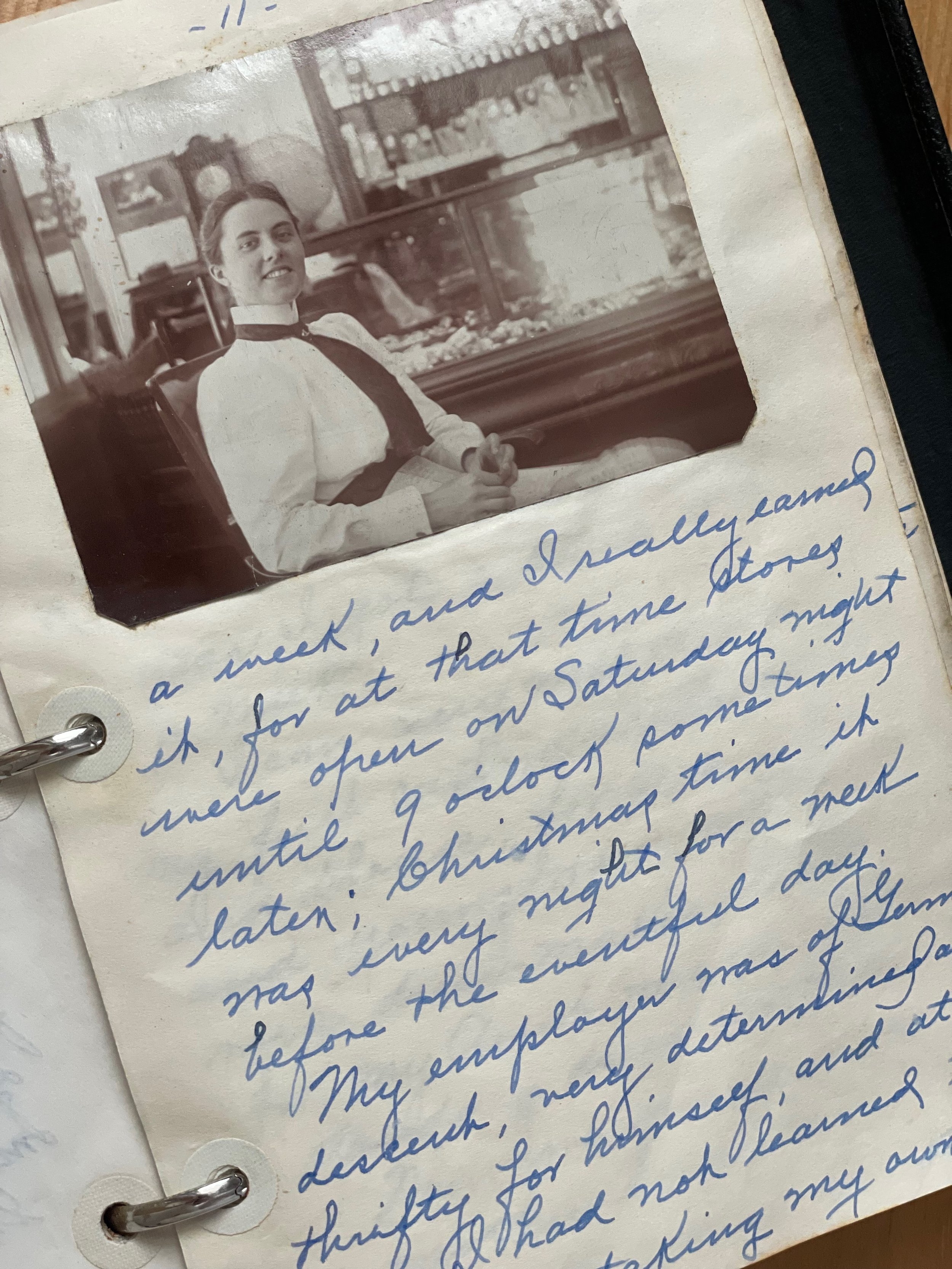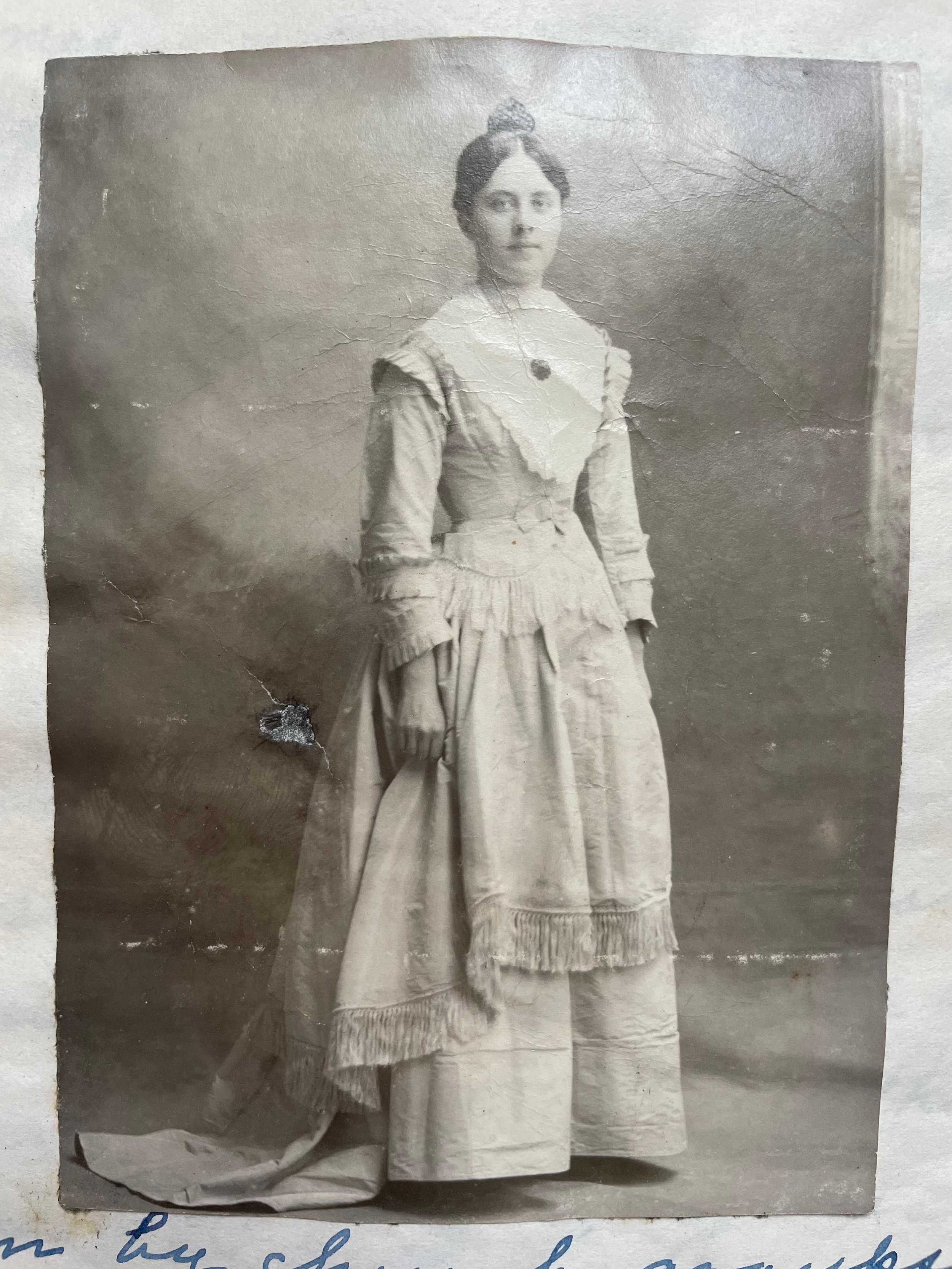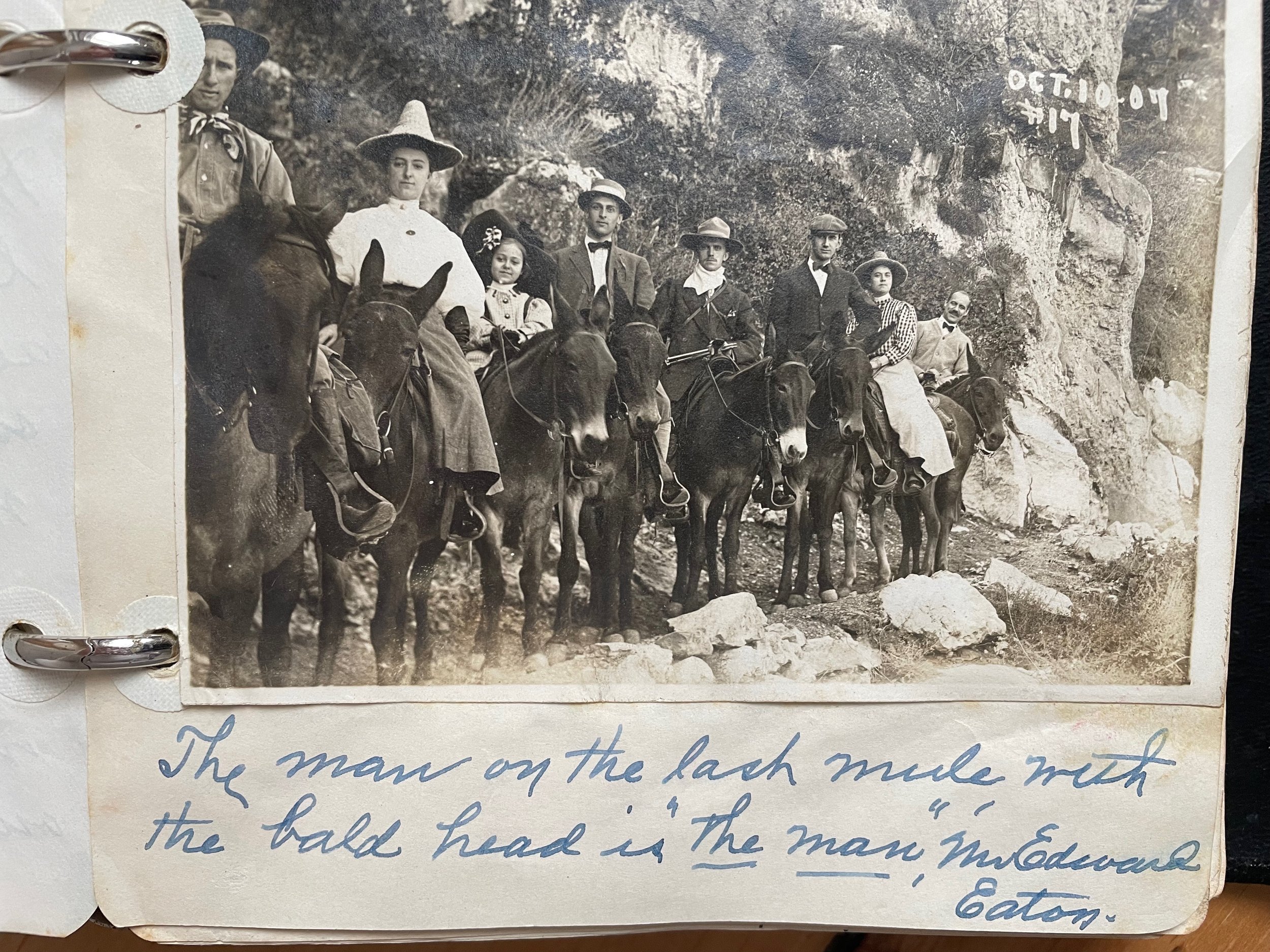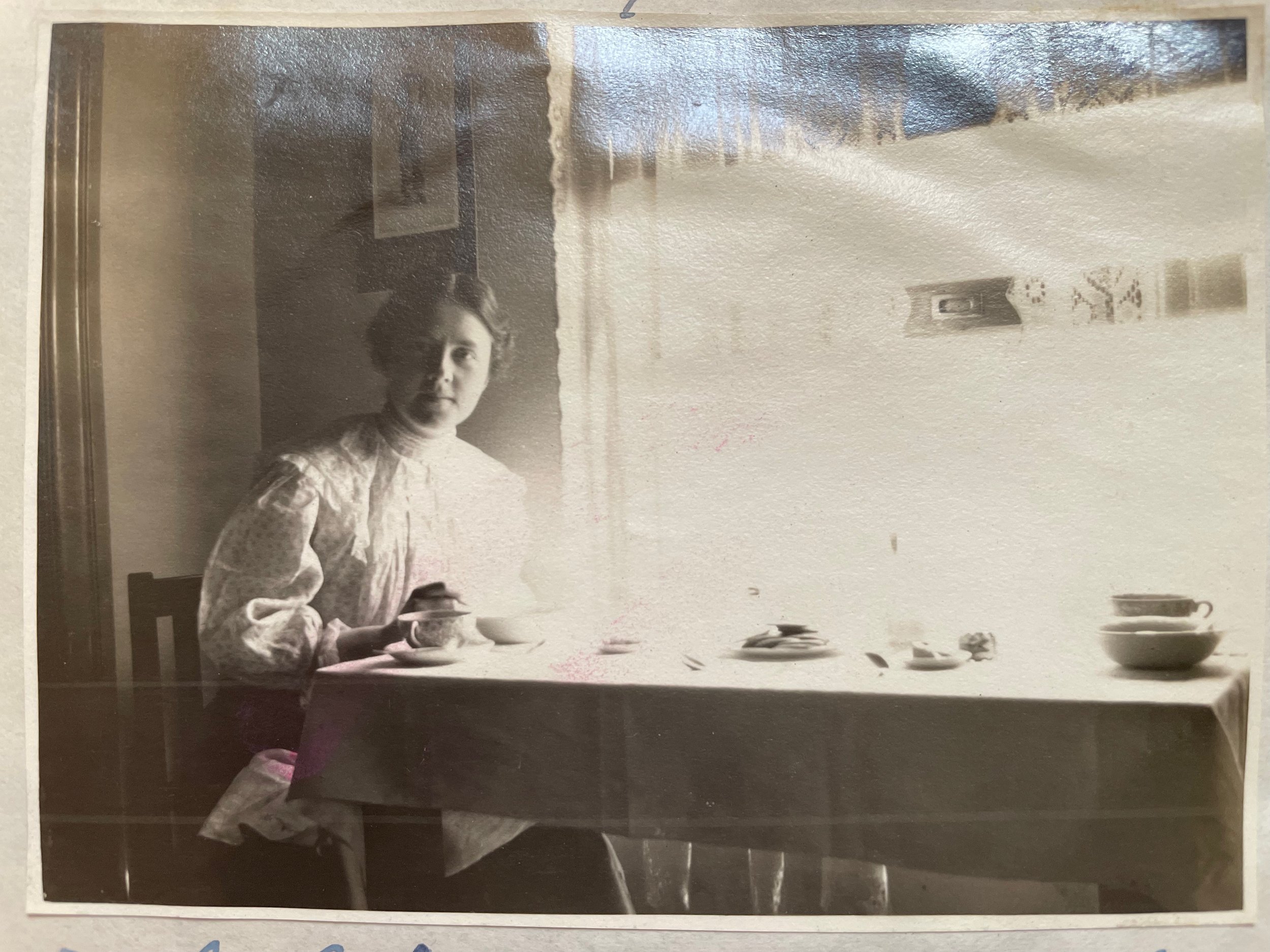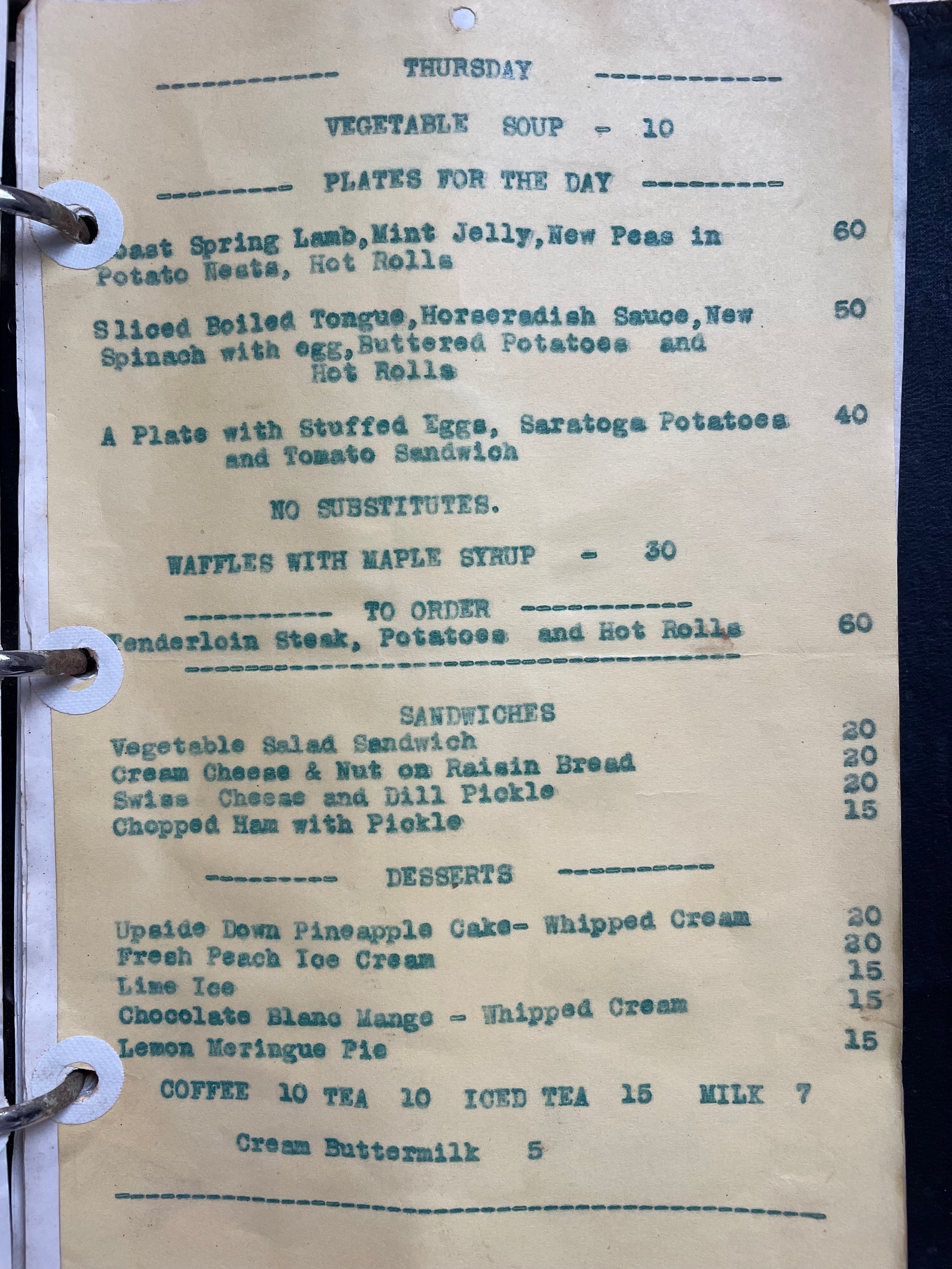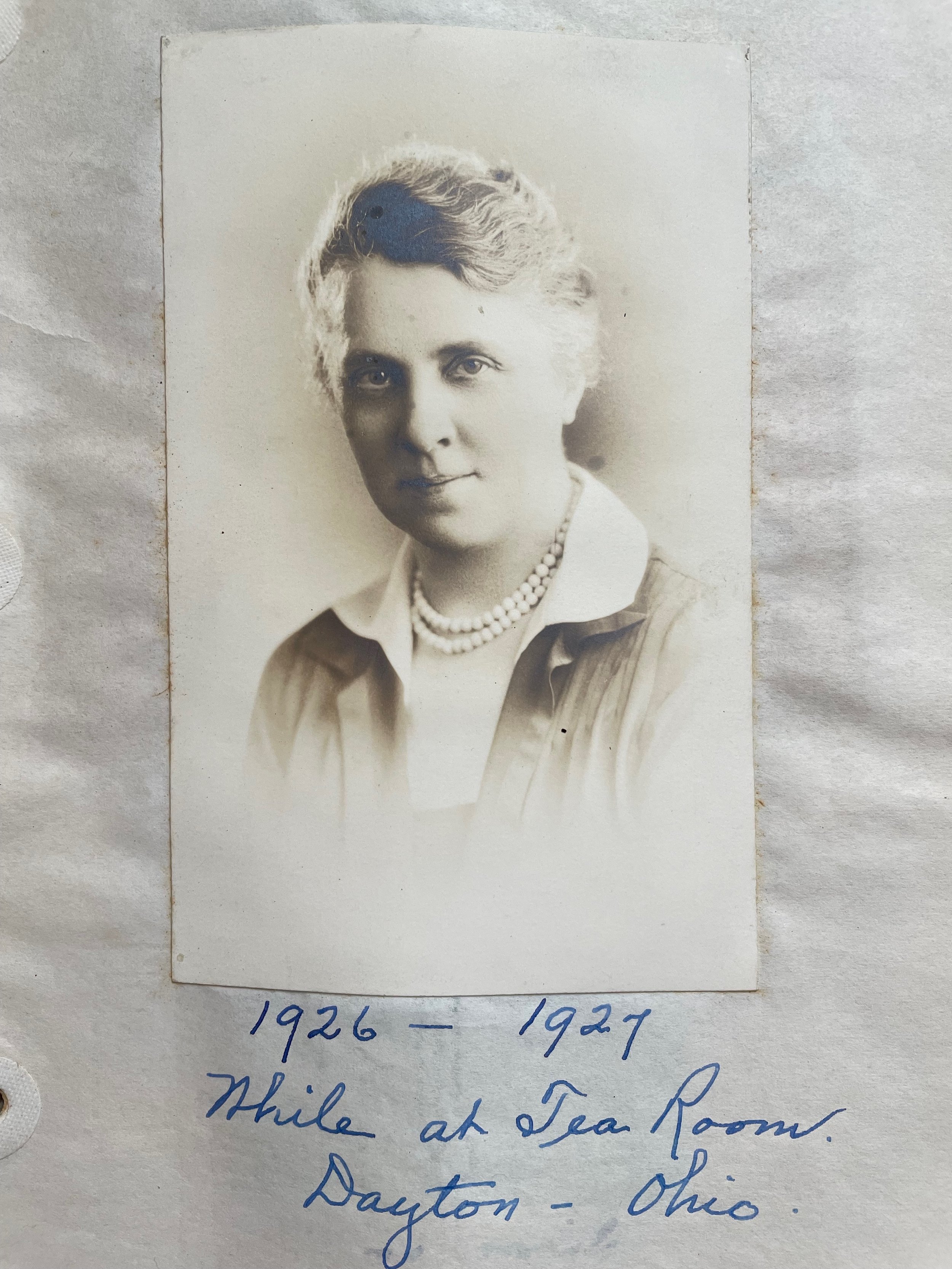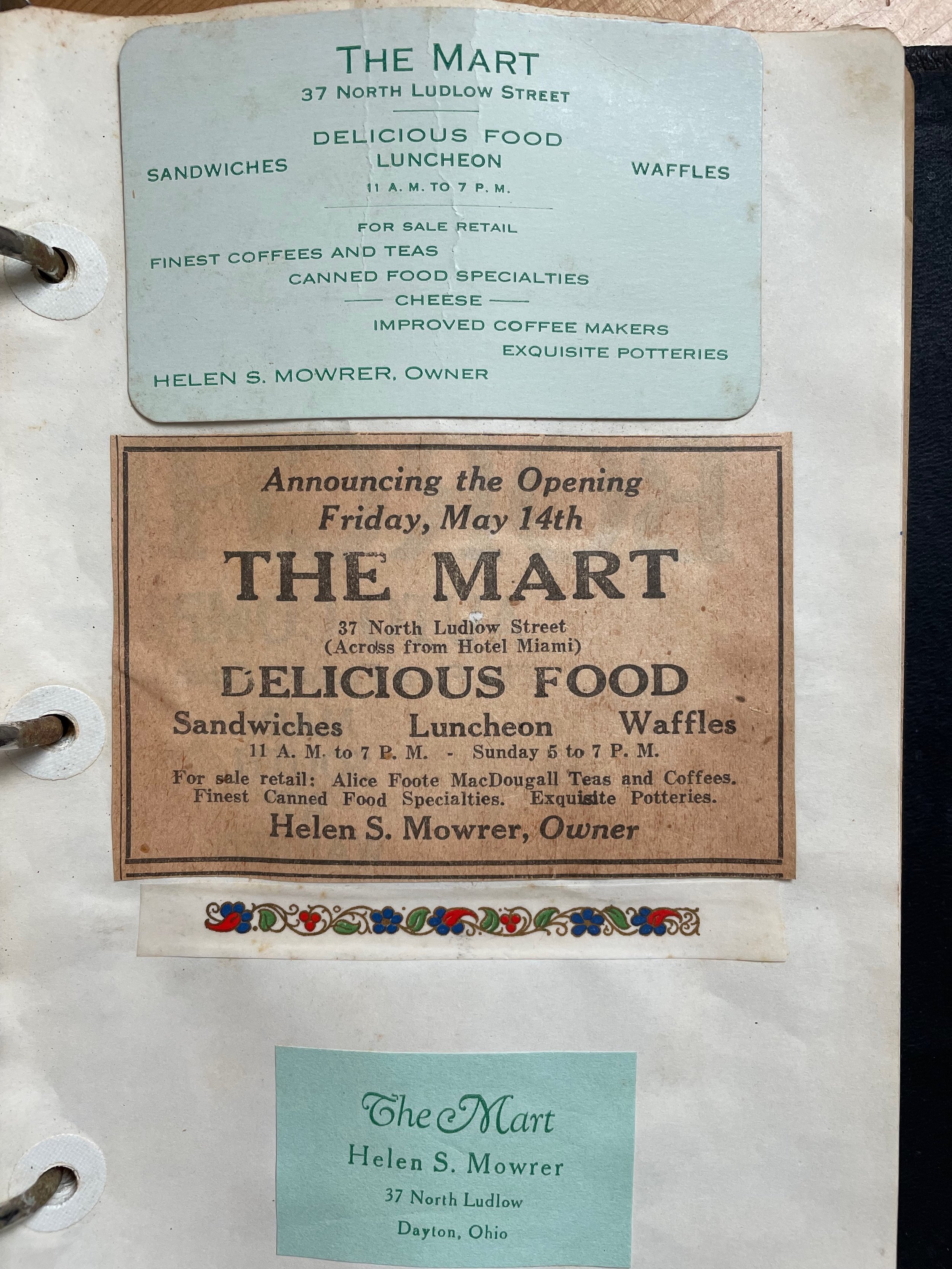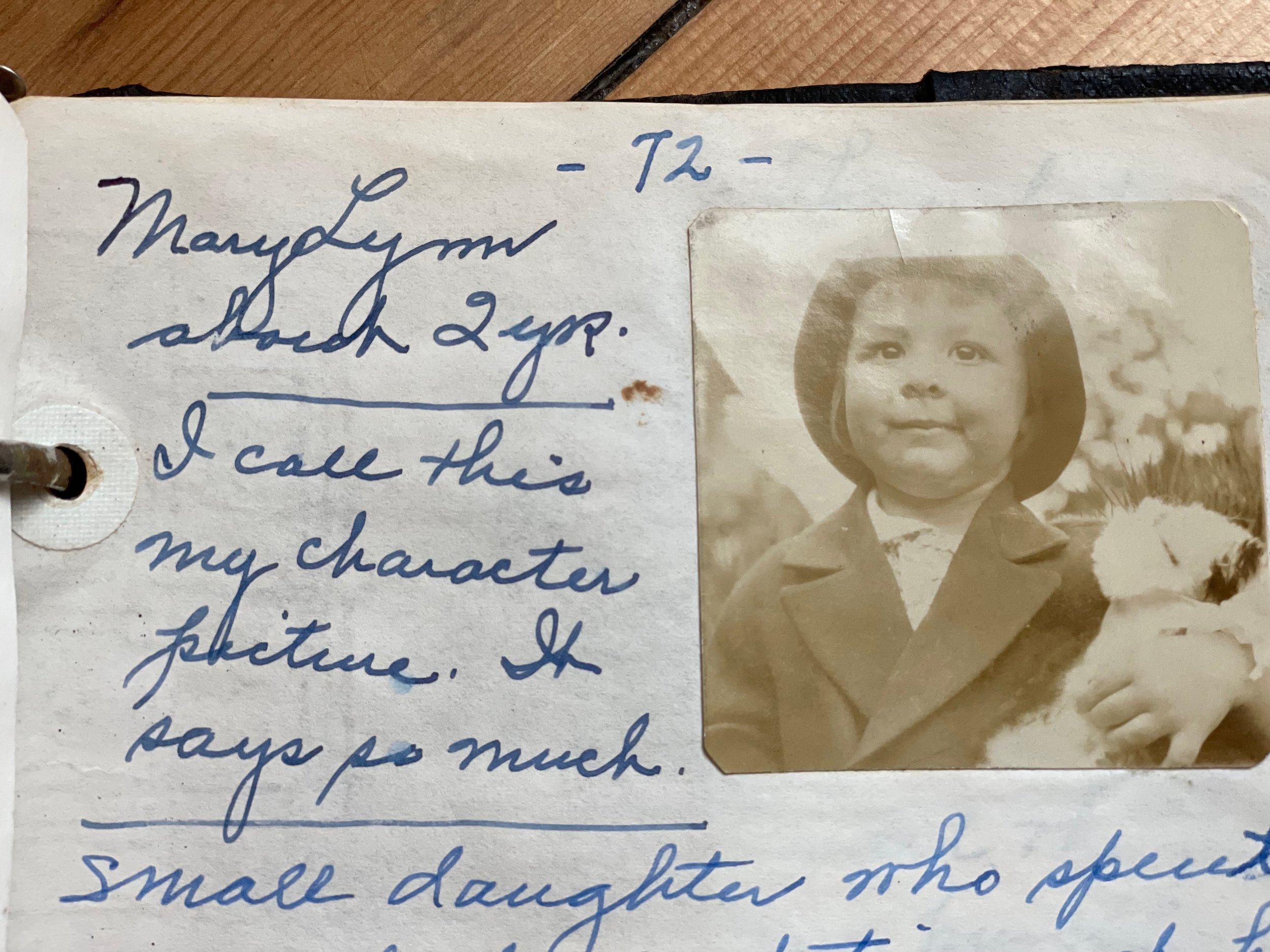Helen Strohm Mowrer
Helen wrote her diary in 1950 to celebrate her retirement at the age of 75. The diary chronicles her life and career. She lived in Xenia, Ohio, never married, and cherished her career in banking and business. Helen was a proponent of women’s rights to be treated equally in the workplace and choose the life that they wanted for themselves.
Introduction
Helen was born in Xenia, Ohio, in 1875. Xenia is just 15 miles east of Dayton. It was founded in 1803, the same year that Ohio was admitted to the Union. The first session of the Ohio General Assembly created the county, Greene County, from the Northwest Territory- the ancestral homelands of the Shawnee and many other Indigenous peoples. The arrival of the Little Miami Railroad in 1843 stimulated development in Xenia, as it passed right through Xenia Station. Xenia Springs later became a tourist attraction, and began bringing people from around the region to the town in 1851 after a hotel and spa was built there. When Helen was born, the population of the city was just under 7,000 people and it has risen to 25,400 today.
Normally, I tell the story of the Diary Writer’s early life before they wrote their diary, then present the diary to you, and then write more about their later life after. In Helen’s case, she has already written the story of her life from her own perspective and in her own voice. She has even provided us with many pictures to go along with it! Because of this, I am going to present her writings extensively, with little additions of my own and pictures of the diary, instead of the more usual way, where my voice often has to take the lead. I have included a complete transcript of her diary as well, as I always do for my Diary Writers. I will have a bit to say after her diary concludes, but again and in typical Helen fashion, she has taken care of most of everything herself.
The Diary
Helen’s diary is a three-ring binder that she filled with unlined paper to write her story on. Most of the pages are numbered, except for a few with pictures, postcards, and newspaper clippings that Helen seems to have included after her story was completed. Some of the pages are regretfully missing. When the diary came to me, the leather cover was in rough shape; it was covered in mold and mildew from water damage. Thankfully, the pages didn’t suffer any similar fate, and I was able to clean the leather with water and rubbing alcohol to stop the spread of the mold (see video).
Helen began her story by telling us exactly what her mission is, “A venture in Remembrance of 50 years of Employment By Helen Strohm Mowrer.” On the last page, we learn that she is writing it in celebration of her retirement in 1950 at the age of 75 years. It seems that her retirement from work, seemingly the measure of her life that she deemed most important, had made her want to reflect on her life. She then tells us her life’s story, beginning with her childhood home, her birth, a description of her parents and siblings, and her early years in school. Unfortunately, page 1 is missing from the diary, so her first sentences are lost.
210 West Church Street
Xenia, Ohio
This is the Mowrer home where the family lived for more than 20 years. All the children were born here. The appearance of the house is the same today…
I was born October 13th, 1875 at 210 West Church Street in Xenia, Ohio, and was the third of six children, all of whom grew to adulthood. The two older were boys, and I had three younger sisters. We were reared in a Christian home, for which I shall never cease to give thanks. As our parents were Methodists, we were reared in that tradition; was active in many church activities, missionary circle, choir, young people’s groups of all kinds…
My first experience in school was in a Kindergarten in the building on the old “Xenia College” grounds on E. Church St. This was my first experience of mingling with other children of my own age… I was not a good student but managed to pass from grade to grade with my friends. On June 21, 1893 I graduated from High School. There were 26 girls and 2 boys in the class. And a good portion of the girls are still living.
Although Helen introduces her 5 siblings briefly here, she only ever mentions her sisters again in the diary, with particular emphasis on the youngest, Gertrude. I have written a description of each of their lives in Helen’s People page, if you would like to read more about them. She then explains a bit more about her parents. While I can track down information about her father, Isaac, it is difficult to find much about her mother, Hannah, as is often the case with immigrants.
I was blessed with wonderful parents, and have had a “goodly heritage” both in health and enterprise… My father was Pennsylvania Dutch, thrifty people, from Lancaster, Pa., and was reared on a farm. His folks were Mennonites, called “plain people.” One thing that did excel in, and that was, in good living. My father was a generous person, very Kind, and thoroughly honest.
My mother was born in County Galway, Ireland, and came to Xenia, Ohio, with her father, to be with relatives, her mother having died when she was 5 yrs. old. A person of a jolly, even disposition, nice appearance, and a gift for liking people, also a love for little children… My mother had the entire supervision over the children of the family and I do not remember that my father, at any time, corrected us. I did not inherit my mother’s sweet disposition or capacity for friendship. And, my close application to business for so many years did not seem to make me so friendly, altho I did make very close friends of a few… I seem to have inherited my father’s methodological habits and love of order.
After this short introduction to her family, Helen moves into describing her career, as she had promised from the beginning. Helen was interested in business, and with the business of banking and investments specifically. Like many first jobs, Helen’s left much to be desired and served as an introduction into the world of working for and with men.
After instruction in bookkeeping, I set out to find a job in 1894. Young women were not employed in industry then, except as school-teachers, telephone operators and helpers about the home as nurses and companions for children. So, I knew of only one or two girls employed in stores at that time. In due time I secured a job as an all purpose clerk in the Schell Jewelry Store being paid $5.00 a week…
My employer was of German descent, very determined and thrifty for himself, and at that time I had not learned to be alert to taking my own part. I did seem to know enough to repulse any attention socially- for he was disgusting in many ways. There were no opportunities to secure a better job, so for 5 years I worked for $5.00 a week- and the 6th year I got a raise to $6.00 a week.
Before we discuss Helen’s exciting adventure, let’s pause and get to know her a little better. Throughout her narrative, her thoughts and feelings about being a woman in her time and her relationship to the institution of marriage, what it meant to act “like a ‘lady’ should,” her career, and the men that she was employed with are woven in. Often, these interests overlapped and Helen seemed drawn to aiding women in business and finance. She was confident, hardworking, and valued the independence that her life choices afforded her. Although she never used this word, she was a confident feminist that knew her worth and saw the injustices that women faced in the workplace and the world around her. This helps to understand her exciting trip to the Grand Canyon as well as many of the decisions that she made throughout her lifetime.
The first indication of this was how she described herself as a child. She was a “‘tom-boy,’ and never let anything stand in the way when I wanted to do it.” This sometimes clashed with the “lady” that her mother and her mother’s friends hoped she would be, but in the end, her mother allowed her to be who she was.
I can very well remember my first custom-made skirt and blouse, for as a girl and young woman, I had worn dress-maker clothes, for my Aunt was an outstanding dress-maker. When we were small my mother loved to make fluffy, attractive dresses for all of her girls, and one of my earliest recollections of her was seeing her day in and day out, at the sewing machine. She loved doing it. How well I remember climbing trees in little silk dresses with lace and insertion, for I was a “tom-boy,” and never let anything stand in the way when I wanted to do it. Some of my mother’s friends would make it a point to tell her of some of my escapades, but it never seemed to bother her, for she seemed to know in time I would act like a “lady” should, and I did.
I rode horse-back, both with a long skirt, and later and later astride with a divided skirt. Also enjoyed tennis, skating, base-ball with the boys, and many other action sports. My mother was always very tolerant. My younger sisters did not follow my example, and later on when they were older there were more dignified entertainments for the young people.
About this time, some of my friends were thinking of marriage, and of all the many girls I associated with I was the only one who remained single, and I’ve never regretted it. Think I had the average, normal chances which come to most girls, but I did not have that urge to embark on an uncertainty. However, I was connected with several weddings and acted as bridesmaid twice and once as maid-of-honor and can truthfully say I always was glad I was not the bride. Not a very normal viewpoint I’ll grant, but have tried to be of service to all the little children and think they are our prize possessions.
… There were many young men in Xenia for several years coming here to attend the United Presbyterian Seminary and many Xenia girls found opportunities for marriage among this group. While I always enjoyed basket-ball games, entertainments, and home parties in their company I never wanted to settle down to any particular one… One evening, a young man came we were not expecting, and my youngest sister, ten (10 yrs) years younger, happened to be entertaining him. He said, “he understood there were four girls in the family” - “No,” she said, “only three,” - then suddenly she exclaimed, “Oh yes! There’s an old one.”... That sister (Gertrude) and I are the ones left now and are quite congenial and the difference in age does not seem to make so much difference now.
Also, Helen never married and she described her decision not to, having never had “that urge to embark on an uncertainty.” She acknowledged that this was “not a very normal viewpoint, and one that was certainly noticed by her family and the young men in Xenia, as illustrated by a story she told about her sister, Gertrude.
Lastly, Helen’s commitment to the advancement of women in business was described explicitly when she was applying for her position at the Young Women’s League in Dayton, Ohio (more about that organization later). When she was interviewed for the position of General Secretary, the President asked her about her opinions on women’s suffrage.
I learned from a friend the Young Women’s League in Dayton were looking for a General Secretary… I sought the President, who was Miss Grace A. Greene, then principal of Dayton Teacher’s Normal School. I found her to be a very approachable person, cordial, and ready to put you at your ease, and interested in the advance of the then known as “working girls.” That was several years before “Women's Suffrage” became a law, but was being discussed by many women, both for and against.
She was interested in my thoughts on the subject, and I did have some very decided opinions, for all my work had brought me in direct contact with men in industry, and the kind of work they were doing. I was doing similar work, in fact, was working side by side with them, but not receiving the same compensation. This went on for some years, and soon as more women were employed in “white collar” jobs, the women (or girls) became more conscious of the injustice the men were pulling off on them, and concerted action developed in time, which brought the desired results. Now, that women’s worth and ability is recognized and appreciated the same as mens, this generation knows nothing about how it all came about before the 1st World War.
A pioneering (her word) feminist (my word) indeed!
Now, back to her story… When we left Helen, she was hoping on a train to Los Angeles, with exciting stops along the way, namely the Grand Canyon. Along the way, she met a new friend.
My railroad ticket was over the Santa Fe, for I planned to stop off at the Grand Canyon in Arizona. I left Xenia in the morning of October 3, 1907… When we reached Williams, Arizona, where you make the side trip to The Grand Canyon, I had the porter put my baggage off and when I got off and saw there were no others making the trip, I was greatly disappointed for I thought there would be several and I did not want to make it alone. So, I asked the porter to put my baggage back on the train and I had given up the trip. Very soon the porter was back with a man who had a nice face about forty or so, whom he said was going to the canyon. Well, I looked him over carefully and he seemed to be dependable when he said he would be glad to assist me in any way that he could. I wanted very much to see the Canyon and I decided to take the chance.
The next day, she and her new friend, Mr Eaton, joined a tour group taking mules to the bottom of the canyon. What an adventure! (although, it doesn’t seem that Helen was too fond of her mule…)
The guide always rode a horse, and the others in the group ride the “sure-footed mule,” as they say, but I did not trust mine. He persisted in reaching over the edge to eat some dried bushes. I am free to say I was really frightened, my knees were shaking, and I would not take my eyes off my mule to enjoy the scenery… Now, trips are taken by automobile around the rim of the Canyon, giving the traveler a splendid idea of the gorgeous changing colors, and some ideas of the beauty and wonder of nature…It is the deepest canyon in the world, bewilderingly and overwhelmingly beautiful- beyond description. I would not have missed it!
When Helen arrived in LA, she shared an apartment with a friend and began a part time job in the City office. After one year in California, Helen decided that her health had improved and she was ready to return home to Ohio. This was when she got her job at the Young Women’s League and, although she didn’t keep the job for long, it seems to have been transformative in her life, also described above.
The League was incorporated for the spiritual, moral, and physical benefit of working women. And a great deal of attention was given to the factory worker and under privileged groups. These board members came from Methodist, Presbyterian, Baptist, Catholic, Jewish, Unitarian, and Christian Science groups and they worked together harmoniously. Working with these women was one of the finest experiences of my life.
In September of 1913, Helen took a job with a furniture manufacturer in New York City. Helen moved often and was a true explorer; she liked traveling and always being challenged with new opportunities. For this job, she also lived in Washington DC for while to manage a furniture showroom there. Soon after this, she moved again to Hartford, Connecticut to take a job in insurance at Aetna Life and Travelers Insurance Company. She never felt comfortable with the people in Connecticut, however, and returned to her home in Xenia, Ohio, and accepted another job in banking. She was there until May of 1915 and then moved AGAIN, back to Dayton to take a job at the Barney and Smith Car Company.
By this time, World War I had begun and “we here in the U.S.A were very much concerned.” This company was important in making railway freight and passenger cars. Helen enjoyed this job and they liked her, but it was a long walk for her in the winter.
The work was very interesting and exacting, for a record was kept of the cost of every thing that was used in the making of a freight car, or a Pullman sleeper, down to the last screw or bolt. The boss of that department told me he never had had anyone work for him that he liked so well. He did not realize a good boss makes a good and faithful employee. Little did I know at that time, that my friend’s boss, who was Manager of the company and held a very responsible position, who thought he was very important, was to loose his job suddenly. Consequently, she left the Company, leaving me the only girl employed there.
Not long after that, just as Winter was coming on- (and it was a very long walk out there) one of the women members of The Young Women’s League board called me on the telephone to tell me there was a job open for book-keeper with the Greater Dayton Assn… She said, “you better consider it, for you don’t want to be going back and forth to The B+S Co. during the winter.” Well, I did consider it and in short time was installed as book-keeper with Greater Dayton Assn.
Still, this job would not last long either. Soon, Helen was get yet another job, but this one was a significant step up from the ones she had had before. She was hired as a bookkeeper and then Office Manager at J.R. Woodhull and Company from 1916 to 1923. Although she didn’t know anything about stocks and bonds, she learned quickly and was promoted to take care of all the female clients of the firm. During this time, “the market broke,” as Helen put it, and she along with many of her clients were “wiped out” financially.
I listened and read all I could about market quotations, book-value, yield and many other things of value to an investor. In time I was given most of the women clients of the company for my special attention, and we got along well. Mr J.R. Woodhull and Mr John Brubaken who made up the company were very careful, and tried to offer only well seasoned securities. I also was most careful to go into much explanation and detail about what I personally recommended to women… We later found out we could be in for a good beating too, if the market broke- as it did in 1929-’33, when I personally was “wiped out.”
Not only did Helen experience tragic financial difficulties at this time, she also experienced tragedies in her familial life as well, or in her words, “the greatest sorrows of my life.” Within 13 months, she lost her mother and two sisters, Mary (1881-1919) and Alice (1883-1920). According to her obituary, Mary died at her mother’s house in Xenia of “acute toxic condition due to goitre.” Although there are other names for this condition now, it sounds most similar to a condition where the thyroid gland in the neck becomes enlarged and produces too much thyroid hormone. The most common cause of goiters is iodine deficiency, and the US has been adding iodine to table salt since 1924 to address this issue. Alice died from complications after undergoing surgery at Columbus Hospital. They were 37 and 36 years old respectively. This obviously affected Helen awfully, both mentally and physically.
Well, it just seemed like the end of everything, and try as I might, I became more nervous, and lost the interest necessary to carry on. For an unknown reason, my left jaw became stiff and very painful. I sought relief in many ways, advice of many doctors, without any relief. Finally, I was to give up my job and for a time follow “the lines of least resistance.” I had bought a small Buick roadster hoping that would give me pleasure, but I had to get well before anything else.
After leaving her job to attend to her health, Helen decided to start her own investment company. During this time, the also joined the Altrusa Club, a national organization for women, and became their National Treasurer. Of this experience, she said, “The Altrusa Club is now International. These friendships are invaluable and bring friendships which could not have been made in any other way. Now that women are considered the same as the men in business, it is through such organizations this recognition has come about, I believe.”
It seems that her little investment business was too solitary a life for her, though, so she quickly started thinking about what she might do next.
I began thinking about having a small Tea Room of my own. I had been fascinated by the MacDougall Tea Room in New York City. So very attractive, and such good food. I had saved a few thousand dollars, which I had invested. In due time, after putting my household belongings into storage, I went to N.Y.C. where I got more inspiration, and bought the most of my equipment- without the knowledge of a place to put them when they arrived in Dayton, O- where I had decided to start my venture. After many disappointments and visions of failure in my attempt, a location was secured- a very central location- in an old family residence, across from the leading hotel at that time. My help was secured, the best available, then I proceeded to furnish the space and make just as attractive as I could financially. The opening was a success and business grew and at no time was it near financial trouble.
Helen named her Tea Room “The Mart,” and she included some newspaper clippings and a menu in the diary. It must have been doing well because it wasn’t long until Helen was approached by someone with an offer to buy her Tea Room! She said that she wasn’t thinking about selling it, but that the deal was good, so she took it.
After this, Helen had the freedom to decide what to do next again. She took a job at the Longfellow’s Wayside Inn in Boston, owned by Henry Ford, for a while, but was upset with the management of the place. This change allowed Helen to take “a year to feed my soul,” by taking a motor trip around the United States from 1928 to 1929! In all, she visited 24 states (some by train), three Canadian cities, as well as several “Historic Points” and College Towns along the way! She knew that she had, “the instinct to wander… I did find congenial spirits with whom I could join forces all over the country, for the time being. It is also true, when you choose to travel alone, you may find ‘gentlefolk’ much the same all over the country.”
For someone interested in business, these years were good ones to step away, as “the worst depression in the U.S. history in full swing” during this time. When she decided to return from the road, she went to live with her sister, Gertrude, in her home in Elizabeth, New Jersey. It was difficult to find work then, and Helen had been so terribly affected by the downturn in the stock market. She said, “Had it not been for my sister’s kindness during that time, I fear I would “have fallen by the wayside” for in 1932, my lifetime savings were completely wiped-out. I was broke.” Gertrude had a daughter, Jane, and Jane had a little girl that was 2 years old at the time. Helen spent a lot of time with MaryLynn and, “She seemed to believe in me, and this gave me back some of my old confidence, which seemed destroyed thru lack of suitable employment.”
By now, Helen was prepared to slow down, but not to stop working altogether. She returned to Xenia, where she had a job with the Franklin Ice Cream Company for a few years, and then took a job with Elder and Johnston Company in Dayton. Pages 74, 75, and 77 are missing from the diary, but we can piece together the last few years described in the diary. It seems that Helen didn’t like that this last company required employees to retire at the age of 70, so she told them that her birth year was five years later than it actually was, “This I did, and then I was retired in July 1950, no one was the wiser for I was in good health and did not look my age. I was really 75 yrs, and had been able to contribute 9 years of payments to Social Security, which I needed. So, this is the last experience of my business life.”
After
When we left Helen in the diary, it was 1950 and she was 75 years old living in Xenia. Not long after, by 1954, she moved to Mount Airy, North Carolina. I wonder how she ended up there! Perhaps the cold in Ohio wasn’t suitable anymore. She lived in North Carolina for eight years before her death on March 24th, 1965.

